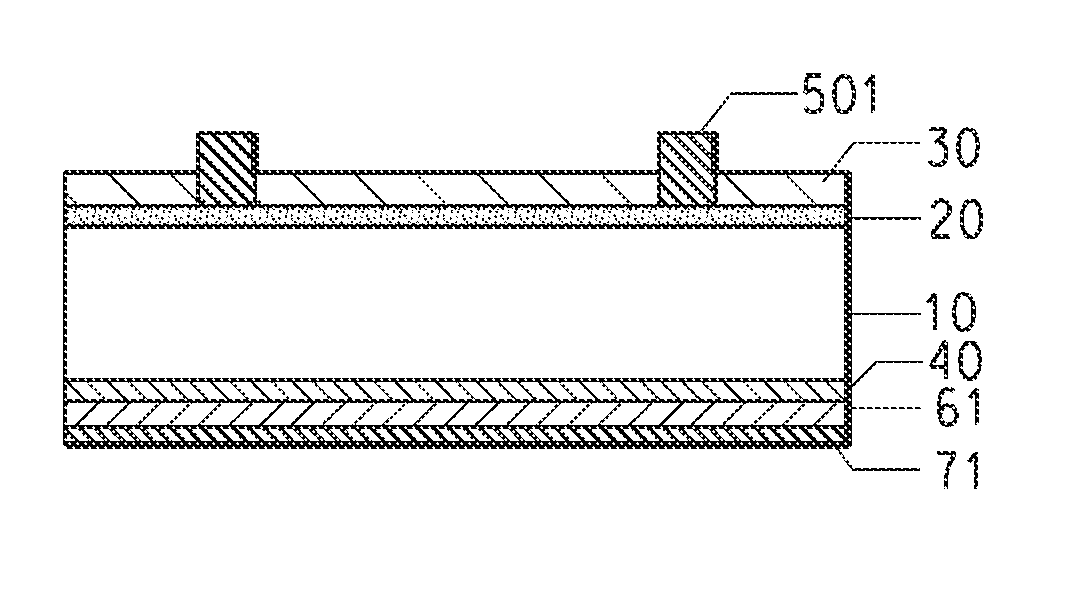Conductive paste composition and semiconductor devices made therewith
a technology of conductive paste and composition, which is applied in the direction of non-conductive materials with dispersed conductive materials, conductors, metal/alloy conductors, etc., can solve the problems of increasing recombination losses that reduce both current and voltage of cells, solar cell energy loss, and voc (open circuit voltage) and isc (short circuit current)
- Summary
- Abstract
- Description
- Claims
- Application Information
AI Technical Summary
Benefits of technology
Problems solved by technology
Method used
Image
Examples
example 1
Paste Preparation
[0148]In accordance with the present disclosure, a series of boron lithium tellurium oxide materials was prepared. The compositions set forth in Table I were formulated by combining requisite amounts of the oxides or carbonates of B, Te, Li, Na, Cr, Ca, and Zn. The amount of each oxide or carbonate was selected to provide in the combined boron lithium tellurium oxide the cation percentages listed in Table I.
[0149]The various ingredients for each composition were intimately mixed by melting them in a covered Pt crucible that was heated in air from room temperature to 1000° C. over a period of 1 hour, and held at the respective temperature for 30 minutes. Each melt was separately poured onto the flat surface of a cylindrically-shaped stainless steel block (8 cm high, 10 cm in diameter). The cooled buttons were pulverized to a−100 mesh coarse powder.
[0150]Then the coarse powder was ball milled in a polyethylene container with zirconia media and a suitable liquid, such ...
example 2
Fabrication and Testing of Photovoltaic Cells
Cell Fabrication
[0156]Photovoltaic cells were fabricated in accordance with an aspect of the invention using most of the paste compositions of Example 1 to form the front-side electrodes of the cells. The compositions used and the amount of frit (in wt. % based on the total paste composition) in each is listed in Table III below.
[0157]Conventional Gintech mono-crystalline HDE wafers (available from Gintech Energy Corporation, Jhunan Township, Taiwan) having a thickness of ˜200 μm and a sheet resistivity of ˜65 ohms per square were used for fabrication and electrical testing. For convenience, the experiments were carried out using 28 mm×28 mm “cut down” wafers prepared by dicing 156 mm×156 mm starting wafers using a diamond wafering saw. The test wafers were screen printed using an AMI-Presco (AMI, North Branch, N.J.) MSP-485 screen printer, first to form a full ground plane back-side conductor using a conventional Al-containing paste, SOL...
example 3
Paste Preparation
[0159]In accordance with the present disclosure, another series of boron lithium tellurium oxide paste compositions was prepared, as set forth in Table IV. The same experimental procedures used to prepare the paste compositions of Example 1 were again used.
TABLE IVBoron Lithium Tellurium Oxide Material CompositionsSamplecation %cation %cation %cation %cation %#BLiTeTiZn252243226.56.52632.2510.75446.56.52726.6221.538.886.56.52830.9910.7545.266.56.52921.521.5446.56.5
PUM
| Property | Measurement | Unit |
|---|---|---|
| wt. % | aaaaa | aaaaa |
| thick p-type | aaaaa | aaaaa |
| thick p-type | aaaaa | aaaaa |
Abstract
Description
Claims
Application Information
 Login to View More
Login to View More - R&D Engineer
- R&D Manager
- IP Professional
- Industry Leading Data Capabilities
- Powerful AI technology
- Patent DNA Extraction
Browse by: Latest US Patents, China's latest patents, Technical Efficacy Thesaurus, Application Domain, Technology Topic, Popular Technical Reports.
© 2024 PatSnap. All rights reserved.Legal|Privacy policy|Modern Slavery Act Transparency Statement|Sitemap|About US| Contact US: help@patsnap.com









